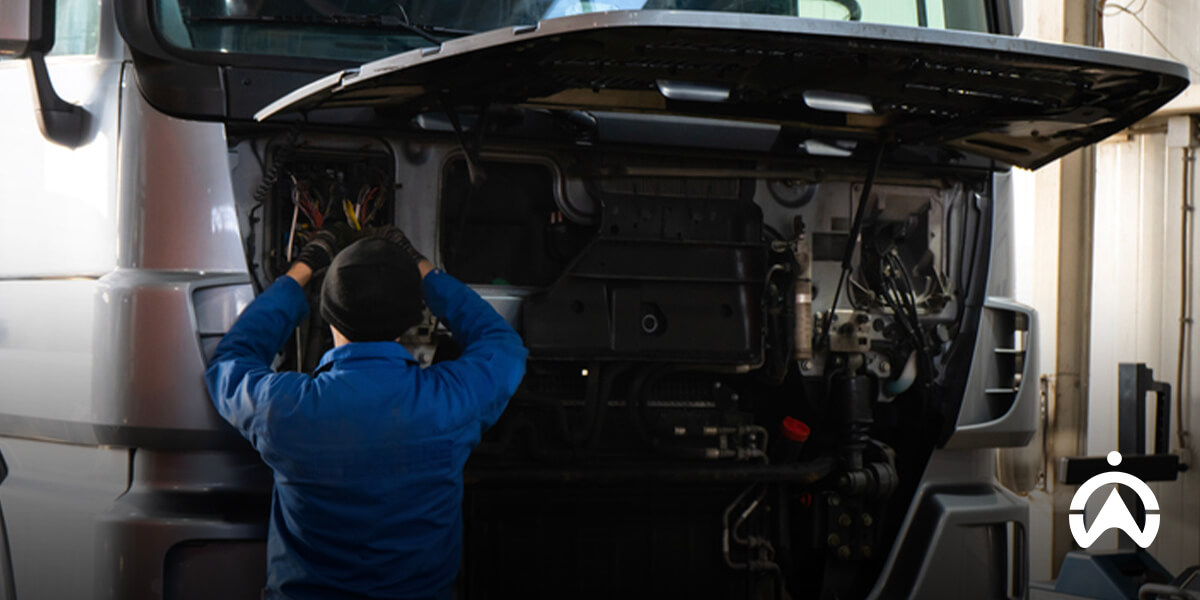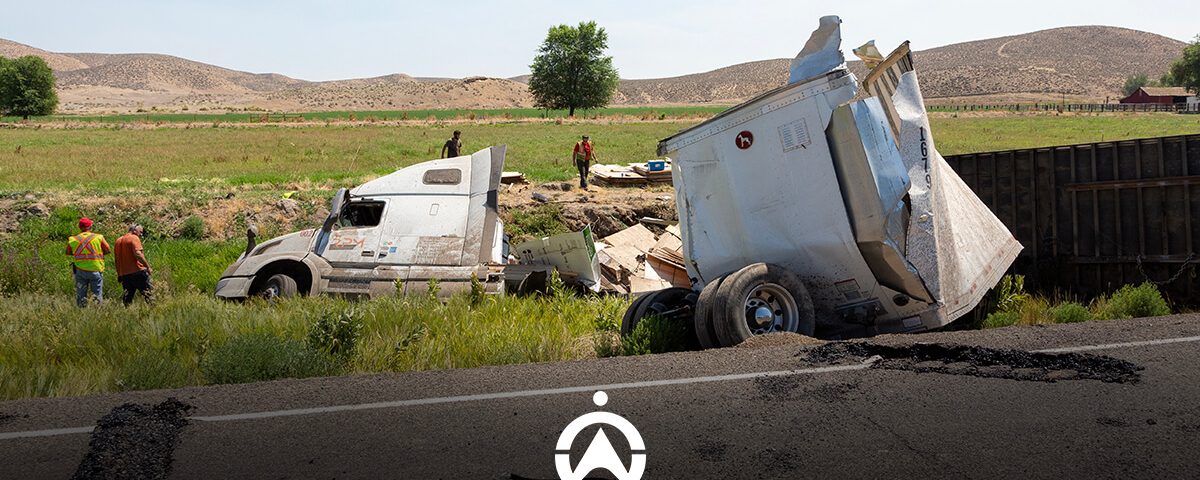What is the leading cause of truck accidents?
The leading cause of truck accidents is driver error. Fatigue is said to be the biggest contributor to driver error, often caused by long hours on the road. When drivers are tired, their alertness, reaction time, and decision-making are all affected, making them more likely to:
- Miss road signs
- Respond too slowly to sudden changes
- Fall asleep at the wheel
According to Studco, various studies reveal that approximately 80% to 90% of road accidents are caused by human factors. In the same article, they state that fatigue is particularly common among commercial and public transport drivers who work long hours. Other major contributors to truck accidents include speeding, distracted driving, mechanical failure, and extreme weather or road conditions.
Let’s discuss why driver error is so common in truck driving, and what you can do to reduce the frequency of accidents in your fleet.
Understanding the main cause of truck accidents
Driver error is the main cause of most truck driver accidents due to a combination of demanding job pressures. The long hours on the road and strict deadlines take a toll on drivers’ physical and mental health. This results in various risky situations such as driver fatigue, stress, and rushing.
According to a study conducted by the Federal Motor Carrier Safety Administration (FMCSA), driver error is 10 times more likely to cause an accident than any other factor. In the same study, they divide driver error into four different categories:
- Non-performance: When the driver falls asleep, has a heart attack, or is physically impaired by something else.
- Recognition: When the driver is inattentive, distracted by something, or fails to adequately assess the situation for other reasons.
- Decision: When the driver is driving too fast, misjudges the speed of other vehicles, or follows other vehicles too closely.
- Performance: When the driver is panicking and is unable to accurately respond to a traffic situation.
What is the leading contributor to truck driver errors
Driver fatigue is a leading contributor to truck driver errors because most of the time, truck drivers spend long hours on the road, often exceeding working hour limits. They don’t take enough breaks between stops because of unrealistic delivery schedules. These circumstances make it difficult for the drivers to avoid fatigue.
The ASANRA (Association of Southern African National Road Agencies) notes that some experts estimate that fatigued driving is responsible for approximately 60% of truck crashes. In the same article, they also highlight how the greatest risk of an increase in drowsiness occurs in the following circumstances:
- After 15 hours of driving, a driver starts a shift before 9 am.
- After 6–8 hours of night driving (when a driver starts a shift in the afternoon or evening).
- After 5 consecutive shifts, when driving again for over 13 hours.
- When driving an early shift that starts after midnight and before 6 am.
- During the first 1-2 night shifts a driver undertakes, and during long night shift sequences.
- When a driver undertakes a backward shift rotation (from an evening, back to the afternoon, or an afternoon back to a morning start.
- After long shift sequences of more than seven shifts.
- During nose-to-tail shifts where a seven-hour break only enables five hours of sleep, a duration previously associated with a threefold increased risk for motor vehicle accidents.
Fatigue can go unnoticed. A tired driver may not feel sleepy but will react more slowly and make more mistakes. It’s as dangerous as drinking under the influence, which is why you need to focus on it to reduce the frequency of accidents in your fleet.
.jpg)
Other major contributors to truck accidents
Other major causes of truck accidents include speeding, mechanical failure, driving under the influence, poor weather and road conditions, as well as improper loading of cargo. Knowing the root cause and addressing these factors is crucial for the safety of your vehicles and drivers.
Distracted driving
Distracted driving is a growing concern among commercial truck drivers. Common causes of distracted driving include:
- Cellphone use
- Eating
- Daydreaming
- Smoking
- Rubbernecking
Speeding and reckless behaviour
Big trucks require more distance and time to stop. When a truck driver goes above the speed limit or drives recklessly, avoiding a collision in a sudden traffic slowdown becomes almost impossible. The truck’s heavy weight and excessive speed significantly increase the force of impact, which can lead to more severe injuries or fatalities.
Mechanical failure
Due to being on the road for long hours, trucks account for a large daily mileage. This means they require more maintenance than smaller vehicles. If you or your drivers neglect regular inspections and vehicle upkeep, critical systems can fail. Brake malfunctions, tyre blowouts, and steering wheel problems are common culprits of truck accidents caused by poor maintenance.
Adverse weather and poor roads
Extreme weather conditions, such as rain, fog, and snow, create hazardous driving conditions for commercial truck drivers. They can reduce visibility and make the road surface slippery, making it harder to control the trucks, which can increase the likelihood of accidents.
Improper loading of cargo
How a trailer is loaded is critical to secure handling. When the cargo is unbalanced or overloaded, your cargo may shift during transit. This can destabilise the truck, resulting in rollovers or jackknife collisions. If cargo isn’t secured, it might even spill onto the roadway, causing more harm to other vehicles on the road. Failure to properly load cargo may result in heavy penalties from regulatory authorities, depending on the severity.
Driving under the influence
It’s no secret that drinking and driving is a major issue in Eswatini. Unfortunately, this also happens with commercial drivers, which has a dangerous impact on public safety. It carries severe legal penalties, like a permanent commercial driver disqualification. For your company, it can lead to reputational damage.
The consequences of truck accidents
Truck accidents can have far-reaching consequences that often result in serious injuries or even fatalities. They also leave lasting emotional trauma for those involved. Your business might face major financial setbacks from vehicle repairs, insurance claims, and lost productivity. Your company may also experience reputational damage and regulatory penalties that affect long-term operations and trust.
Here’s a table breakdown of the main effects truck accidents can have, according to three categories:
How to prevent truck accidents
Preventing truck accidents starts with simple but consistent safety habits from everyone involved. This includes drivers, managers, and other staff members within the company. From there, you need to invest in technologies that enhance driver awareness, such as AI dashcams and telematics. Combining technology with consistent safety habits reduces the chances of mistakes.
Here’s how each group can play its part in keeping every journey safe and smooth:
For drivers
When it comes to road safety, drivers are the first line of defence. You must ensure that your drivers take enough rest breaks between trips so they can maintain concentration and alertness. Your drivers must also get enough sleep prior to lengthy travels so they have a good amount of energy and sharp thinking. Lastly, avoiding distractions like eating or using cell phones while operating vehicles can make a significant difference.
For fleet managers
As a fleet manager, you play a key role in preventing accidents by using smart fleet management tools that help you keep track of driver behaviour. It’s also important that you develop strict policies against distractions such as cellphone use, so drivers know the consequences and therefore avoid doing so.
You should also ensure that cars are kept in good condition by performing routine safety inspections of vital components such as brakes, tyres, and lights. Also, keep in mind the importance of driver wellness programs to ensure that drivers are coping.
To further reduce stress and exhaustion, you must ensure that driver schedules and deadlines are realistic to promote rest periods. This ensures that your drivers have enough time to finish deliveries safely. Drivers are more likely to take safety seriously when managers set a good example.
For companies
Your company needs to create a culture that values safety. One way this can be done is through driver incentives. Offering rewards for safe driving practices promotes improved team behaviour. Businesses safeguard their employees, vehicles, and reputation when they prioritise long-term safety over short-term profits.

Reducing truck driver accidents with Cartrack
At Cartrack, we have various technologies that’ll enhance the safety of your drivers and ensure that your business adheres to safety regulations. Over the years, we’ve had a hand in combating the frequency of accidents in many industries, including transport and logistics. We offer advanced and easy-to-use vehicle safety and monitoring technology, all from one platform.
Have a look at our top solutions for avoiding truck driver accidents:
AI Dual Vision camera
Cartrack’s AI Dual Vision dashcam helps you monitor driver behaviour. Its distracted driving detection capabilities include drowsiness, fatigue, eating, looking away from the road, smoking, and cellphone use. Once detected, it gives out an audible alert so your drivers can quickly correct their actions. This camera further enhances driver alertness by detecting blind spots and when drivers are tailgating.
Our AI-powered dashcam also has telematics capabilities, helping you notice other leading causes of accidents, such as speeding, harsh braking, and harsh cornering. It also has GPS technology, making sure you always know where drivers are.
Predictive maintenance
Prevent accidents caused by mechanical failure by using our preventative maintenance system. With this, you get alerts of engine issues, worn-out brake pads, and oil-and-water fluctuations. You can also use our system to keep up with vehicle service dates so you don’t have unexpected breakdowns.
Logbook
Manually logging driver hours leaves room for human error or fraud. It can create the impression that drivers are within their hours limit when, in fact, they’re not. The Cartrack digital logbook helps you keep up with driver working hours, ensuring that they’re accurate. This helps your business remain compliant, assists in creating schedules, and gives drivers enough rest. This is yet another way to prevent driver fatigue and reduce stress levels.
DID tag
In many cases, drivers share vehicles, and it becomes difficult to know who used which truck. With our Driver Identification (DID) tags, we to instantly know which driver is using which vehicle. Should anything happen, you’ll know exactly who must be held accountable. It also helps you ensure that the correct driver is assigned to a truck they qualify for, as each tag is linked to one specific vehicle.
Driver Scorecards
The Cartrack Driver Scorecard system is a great way to promote a culture of safety within your team and motivate your drivers. This is a system that monitors how drivers operate vehicles and rates each driver according to the number of harsh events detected. Through this, you can give recognition and reward high-scoring drivers, and use it as an opportunity to address issues of those who need improvement.
Your fleet’s safety starts with Cartrack
Driver error presents many risks for trucking businesses; however, there are various other major causes of accidents that you should also look into. As a fleet manager, you must invest in advanced driver monitoring technology to help your drivers avoid accidents. Protect your drivers and assets — see how our fleet management solutions improve safety. Contact Cartrack today!
Frequently Asked Questions about Truck Accidents
Where do most truck accidents occur?
Most serious accidents (including those involving heavy vehicles) in Eswatini occur on the country’s major arteries: notably the MR3 highway, which connects Mbabane, Manzini, and Ngwenya, and is one of the busiest roads in the country. Other major routes, such as the MR7 (“Mbandzeni Highway”) and MR8, also form the backbone of Eswatini’s transport system.
What are the 4 causes of accidents?
The four common causes of accidents are distracted driving
- Driver error
- Drunk driving
- Speeding
- Vehicle faults
Other causes of accidents include reckless driving, poor weather conditions, jaywalking, and driver inexperience. Understanding the cause of road accidents is crucial for developing effective safety precautions to prevent future collisions.
Which country in Africa has the most car accidents?
According to an article by Business Africa Insiders, Nigeria has the highest number of road traffic fatalities, followed by Ethiopia and DR Congo. However, when measured per 100,000 population, Kenya, Ghana, and South Africa recorded much higher fatality rates.
Are older drivers safer?
Yes, older drivers are generally safer than younger ones. This is because they have years of experience and are more cautious when driving. However, the Centers for Disease Control and Prevention reports that drivers aged 70+ have higher road accident fatality rates per 1000 crashes compared to middle-aged drivers (aged 35-54).
Why are there so many car accidents in Eswatini?
Eswatini has high accident rates because of a mix of human factors and environmental factors, but primarily human factors. Human factors include things such as reckless driving, speeding, fatigue, and distractions. Environmental reasons include poor road conditions, such as potholes, as well as bad weather.
Reduce the risks! Explore the Cartrack driver monitoring tools.




